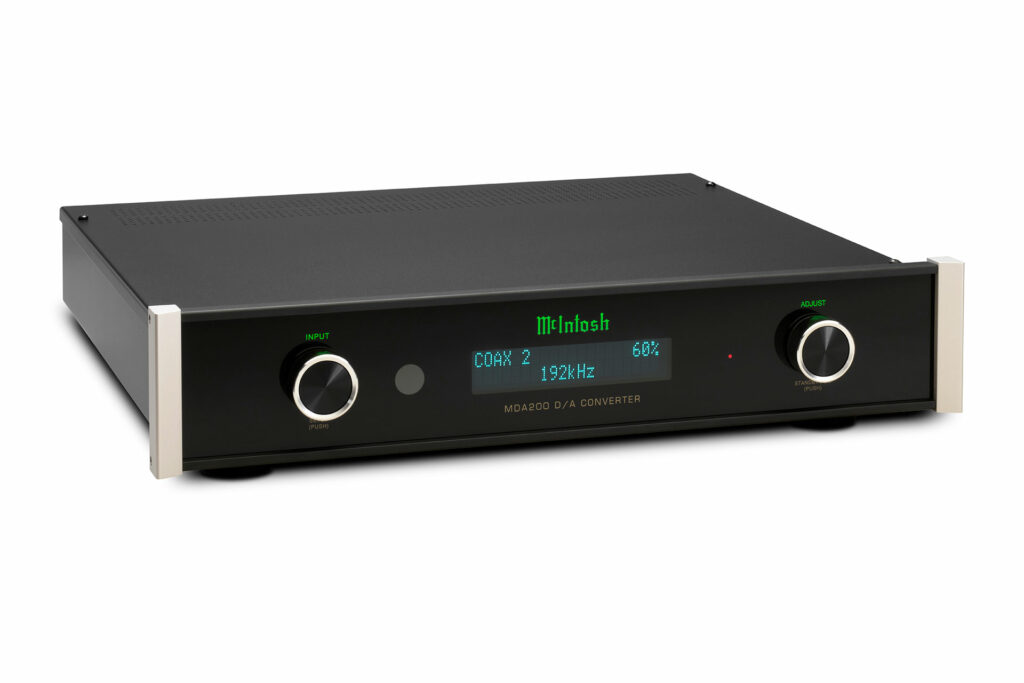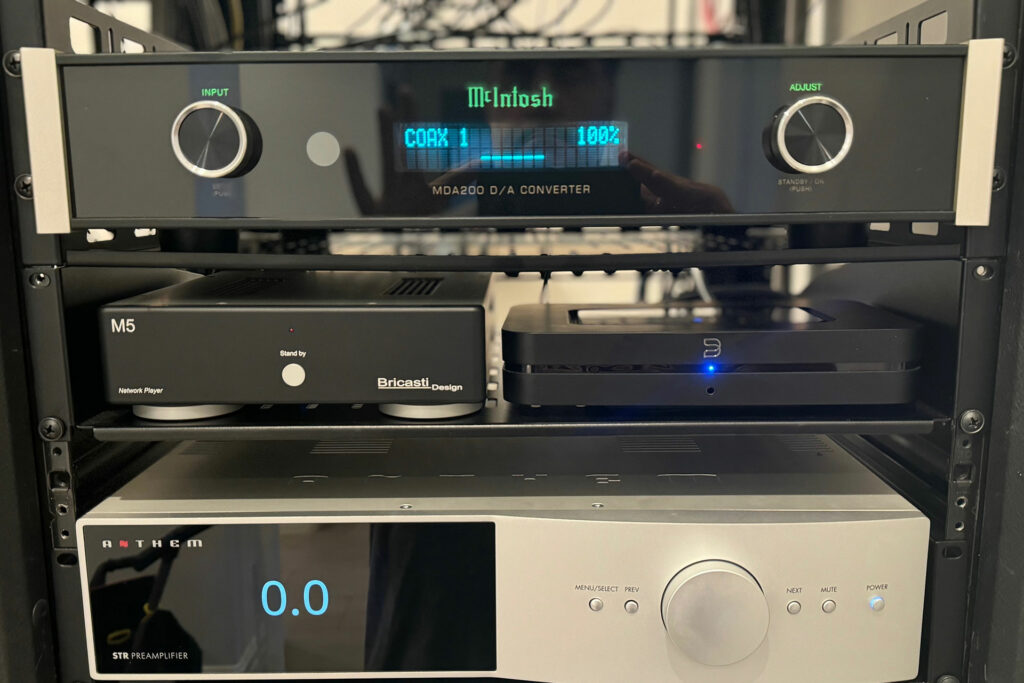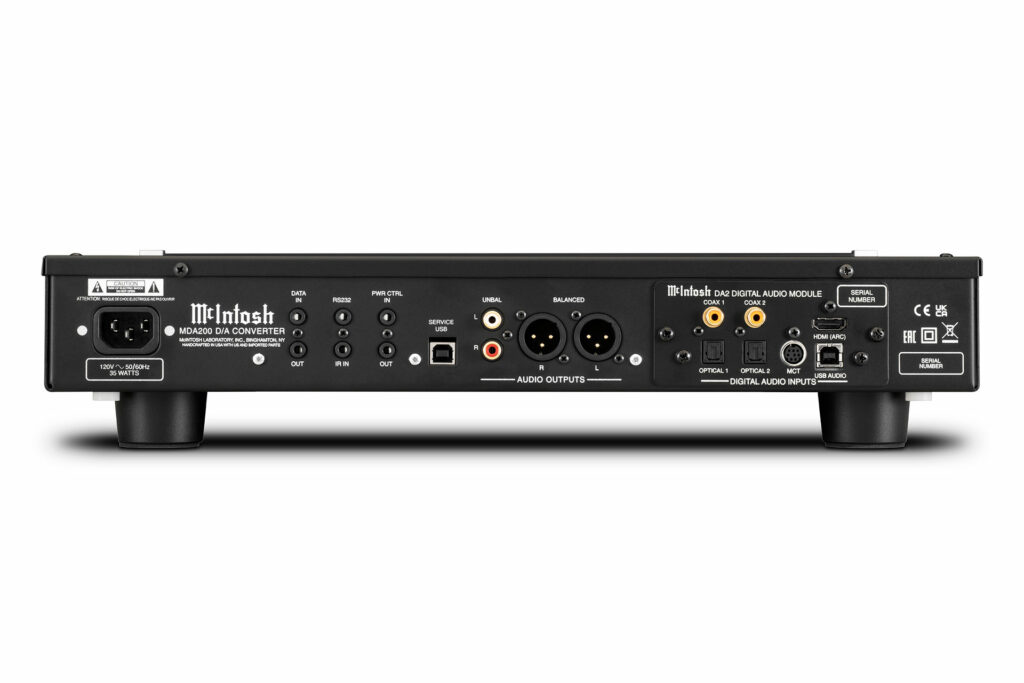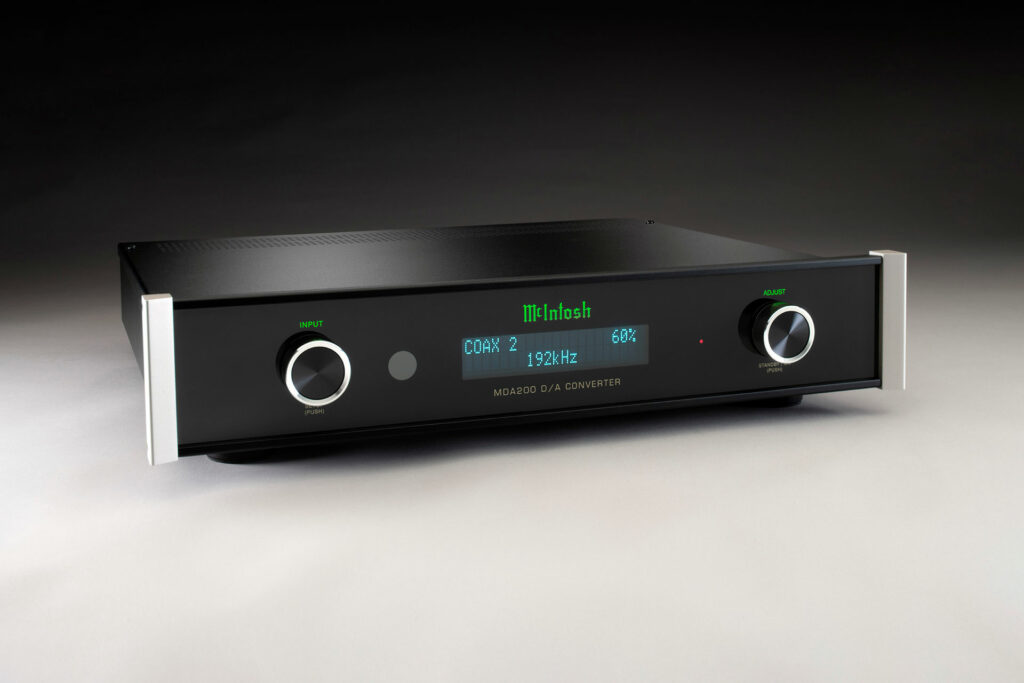Perhaps no single brand in the history of audio defines the high end of the hobby more than McIntosh. The marquee’s legacy dates back before the boom in popularity of music, as well as audio, in the late 1960s. In the 1970s, successful touring acts like The Grateful Dead used McIntosh gear for their famed “Wall of Sound.” Today, McIntosh is the healthiest and most well-represented brand of the establishment high-end audio electronics brands. McIntosh has national distribution via Magnolia stores (inside of Best Buy), as well as a major uptick in support from the custom installer space. Their blue-lit meters are now not just found on the front of a 1000-watt monoblock power amp, but also on the giant touchscreens inside of $100,000 Jeep Wagoneers. Today, McIntosh is kicking ass and taking names as they work to ultimately appeal to a new generation of client.
The McIntosh MDA200 (buy at Crutchfield) is the one and only digital-to-analog converter in the company’s product lineup. Priced at $4,000, the McIntosh MDA200 DAC is a full-width, two-rack-spaces-tall audiophile component that comes dressed in the traditional McIntosh livery (meaning blue lights, glass front and the overall McIntosh design language). At $4,000, there is fierce competition for one’s digital-to-analog converter money. This is a very simple unit, designed for quality sound, ease of use and to appeal to legacy clients in need of an upgrade. How does the McIntosh MDA200 compare in a brutally competitive world of DACs at or near this price point? That, my friends, is our challenge …

What Makes the McIntosh MDA200 DAC Special?
- The McIntosh MDA200 is a well-built DAC that is voiced to make more of your music sound more musically engaging and approachable, without the use of user-controlled EQ. It also uses some of the best DAC chips from ESS that are well-regarded in engineering as well as audiophile circles.
- There are lots of input options for the McIntosh MDA200, including two S-PDIF (COAX), two optical, one MCT (for a native McIntosh connection for CD/SACD players), one HDMI (for ARC use with a TV) and one USB input.
- Balanced and unbalanced outputs are offered on the McIntosh MDA200, which is nice, as not all DACs today offer both options.
- The internal upgrade path for the McIntosh MDA200 isn’t mentioned, but the physical path is, meaning that that someday you can replace the DAC card with a new one that could support new formats or possibly use new DAC chips (semiconductors). Many DACs in this price range are doing this with software or firmware updates. McIntosh is making its upgrades more in the physical domain.
- DSD is supported as are other very high-resolution – high sample rate formats. Reportedly, the McIntosh MDA200 can accept signals that go as high as 24/192 (384 kHz via USB), which is about the best that you will find today on an HD disc or, more likely, coming from an HD streaming format like the QoBuz that I used for my listening tests.
- While I used the Lumin D3 as a streamer into the McIntosh MDA200 for a little while, I used the game-changing BlueSound Node (read the review) for most of my listening. For those looking to use one of the top audiophile music management software platforms, the McIntosh MDA200 is a Roon Tested product. Roon Tested devices work over USB, HDMI, AirPlay, Google Cast, and other protocols. The GUI on Roon is great, but the meta-data is what power users rave about with that software.
- Today, television is making some of the best content in the world (sorry, Hollywood movie studios), and the McIntosh MDA200 has an HDMI input that features ARC so that you can connect a TV (or other ARC components) and synch them with your audio system. While I like to listen to some classic Hendrix or even the new Beyoncé album, I also like to listen to the soundtrack of Billions, Fallout or Hacks (good shows, folks) through my reference audio system, and the McIntosh MDA200 goes that extra step to provide a slick connectivity option.
- Most audiophile DACs aren’t very custom installer-friendly, but the McIntosh MDA200 sure is. There are RS-232 control connections, as well as other triggers to use to control the McIntosh MDA200 in your system. I didn’t have the unit here long enough to trick it out on my Crestron Home system, but I could have if I had more time and wanted to invest the money in the programming. In the right system configuration, this could be a really compelling design advantage for the McIntosh MDA200 DAC.
- Like many DACs today, you can use the McIntosh MDA200 as a digital preamp, but you need to take it out of unity gain mode. I didn’t do this, as I managed volume using an analog input of my reference Anthem STR stereo preamp.

Why Should You Care About the McIntosh MDA200 DAC?
There are going to be two camps of potential clients: new audiophiles who are seeking the McIntosh experience, and the many legacy McIntosh clients who have systems that need to function in a modern audiophile world, which includes HD formats, HD streaming, in this case (thankfully) television sound, and more. The McIntosh MDA200 delivers for both audiences at a pretty fair price when you look at the overall high-end audio market.
Some Things You May Not Like About the McIntosh MDA200 DAC …
- Some key inputs are missing on the McIntosh MDA200, including I2S (HDMI) for HD audio, and AES-EBU, which is a professional audio digital connection that uses XLR connectors and is considered to be one of the best ways to connect sources to a DAC in the digital domain.
- While the chassis of the McIntosh MDA200 is rock-solid, the knobs don’t have a good feel to them. A $4,000 DAC needs to have a sexier and better hand-feel when changing inputs and so on.
- MQA is trying to make a comeback. I am not sure if it will be anything in the future, but the McIntosh MDA200 doesn’t seem to support the now-dead format. This is far from a critical knock on this audiophile component, just a small point for the MQA-loving audiophiles out there.
- While I would likely never use user-controlled “filters” (EQ, really) in a DAC, some like those options as something to play with, and the McIntosh MDA200 doesn’t have them. The DACs that I like the best are from professional audio companies, and they too don’t have EQ/filters at this stage. I am glad the McIntosh MDA200 doesn’t either, but it is worthy of note for those who do care, even if I am not one of them.
Listening to the McIntosh MDA200 DAC …
A lot of really cool gear has come in and out of my system recently, including the PS Audio Stellar Gold DAC and the Lumin D3 DAC/Streamer. The McIntosh MDA200 was mostly fed by a BlueSound Node and connected to an Anthem STR stereo preamp, a Pass Labs XA-25 Class-A power amp, and played through Bowers & Wilkins 802 D4 loudspeakers using Wireworld cables.
A lot of the music that I used in this review I’ve referenced in previous reviews, including this “instant audiophile classic” from Beyoncé’s new country record. She actually had the creative fortitude to cover a Beatles song in “Blackbird,” which is a modern, cost-no-object recording that shows what the best of the best recordings sound like through the McIntosh MDA200. This COVID-era recording session is lush with vocal overdubbing, and sounds sweet to the ears with the McIntosh MDA200 DAC in the loop. Bass sounds fantastic, but the layered vocal overdubs are even more compelling. The soundstage is very wide, and nothing sounds harsh or too brash. There’s a slight smoothness to the sound that is appealing sonically, especially compared to my Benchmark Media DAC3 B or my Bricasti M3 DAC – which are both very raw, accurate and tight-sounding digital-to-analog converters.
One of the torture tests that I’ve been using on the DACs and streamers that I’ve been reviewing is to take early 1980s digital recordings to see how they perform in the modern digital audio world. “Sledgehammer” from Peter Gabriel’s SO album is a perfect example of an important recording, but one that suffers a bit from the recording technology of the time. The McIntosh MDA200 couldn’t re-record this Peter Gabriel solo record (nor would we expect it to), but it did take just a slight bit of the zip out of the high frequencies, which might not be as studio-accurate, but makes for a pleasant listening experience. The Tony Levin Chapman Stick sound (like a bass guitar) goes deep and sounded great with the MDA200 in the loop. Manu Katché’s drums is where a little of the thinness comes through. I don’t want a DAC to change the music, which is why I use what I use for my reference, but it was interesting to hear what the McIntosh MDA200 did with tougher, early-digital music.
“Touch of Grey” by The Grateful Dead in HD via QoBuz was perhaps the best that the McIntosh MDA200 sounded in my system, and isn’t that a bit ironic? I know real Dead Heads think this hit record is the “Owner of the Lonely Heart,” 1980s sellout moment for The Dead. Perhaps the critics are right, but I love nearly all of those so-called sellout songs from back in that era. Let’s call them guilty pleasures. The warmth and openness of the McIntosh MDA200 brings a coherence to the hit song for the world’s most significant jam band. Again, like on the Beyoncé track, you hear great depth with no harshness (a better recording than, say, “Sledgehammer” or Whitesnake’s “Here I Go Again,” which has the same issues from early digital recordings that no DAC likely can fix …). The thing that stuck me about the sound on “Touch of Grey” was the musicality and overall coherence, which was just fantastic.
Does the McIntosh MDA200 DAC Have Any Resale Value?
The MDA200 is a McIntosh component, so the answer is an enthusiastic yes. The McIntosh MDA200’s ability to have card-based upgrades helps, too. So does McIntosh’s robust distribution, paired with their world-class audiophile legacy. Simply put, you will always find a buyer for a McIntosh MDA200, and likely at a pretty fair price, as McIntosh is about as blue-chip as it comes for an audiophile component.

What is the Competition for the McIntosh MDA200 DAC?
The first DAC that comes to mind is the PS Audio Stellar Gold DAC (read the review) at the same $4,000 price. The PS Audio DAC is a more modern component with better build quality. The design is a little fancier, and the upgrade path for this DAC (they’ve already proven this concept on their $7,999 DAC, mere months after its release) is proven. The PS Audio isn’t quite as soft-sounding or sonically forgiving, and I like that in a DAC.
I mentioned my Benchmark Media DAC3 B (read the review) which at $1,899 is significantly less money, and a very well-respected digital converter. It is also a smaller, professional audio DAC that takes the “girl who doesn’t need makeup” approach to music playback. If your recording is ugly, you will hear it. If your recording is killer, expect to be impressed, as the window to your music is clear. The McIntosh MDA200 delivers a more even-keeled approach to the sound, which many listeners will like. Those looking for the most resolute, dynamic and accurate sound might like the Benchmark more.
My reference Bricasti M3 DAC at $6,000 (read the review) is another world-class, professional audio DAC that is beyond resolute. The high-frequency openness on the McIntosh MDA200 is great. It is even better on the more expensive Bricasti, as you should expect. Where the big gains are had are in the higher frequences, which are pure, crystalline and almost addictive. Older listeners who may have, over time, lost a little of their high-end hearing might like the more welcoming sound of the McIntosh MDA200, but the Bricasti is more revealing overall.

Final Thoughts on the McIntosh MDA200 DAC …
Taking one’s Lamborghini to the grocery store can be a challenge for any of us. Every parking lot speed bump is a potential hernia-inducing moment. The aforementioned professional audio DACs are the audiophile example of this concept, and not everybody loves that sound, which is perfectly OK. The sound of the McIntosh MDA200 is more analogous to taking one’s Bentley SUV down to Bristol Farms or Eataly to get some winter white truffles and house-made burrata. You are going to be able to navigate Beverly Hills traffic better and arrive in style in the Bentley, which has a little bit more forgiveness in the suspension than the Lambo. That describes the appeal of the McIntosh MDA200 DAC, which is a sonic smooth operator.
The McIntosh MDA200 is a fine performer and a solid value at $4,000. It is a digital-to-analog converter, capable of providing world-class sound that is warm, engaging and musically easy to listen to. If you are upgrading from a legacy digital component and you power this with any number of HD music sources via, say, Roon (or any number of other options like my BlueSound Node), you are going to get some drastically upgraded sound that anybody can hear and that everybody can enjoy.




Reviewing a DAC without telling the reader — specifically — what kind of ESS DAC chip is used?
Like reviewing a Ferrari without mentioning the engine.
I believe this is the same chip set in the Topping D90 (great for the money) as well as the recently reviewed Lumin D3 streamer
It is their best chip set, I believe but that can change.
It was a solid DAC. Strong performer but strong competition. I kept my Bricasti at $6,000 (much more money) which is a little better. 🙂
Hi. A nice review. My comment does not necessarily pertain to the abilities of the DAC. I noted that you mentioned that the knobs feel a bit flimsy. I have read that same concern regarding other McIntosh products, some more expensive than this item. Do you have any thoughts on why the company does not address this? Is it solely a cost-saving measure? Thank you.
I would be almost tempted to buy some piece of McIntosh gear because of the looks….especially the green and blue lights! The fact that they sound good is an added bonus.
An excellent review. My “take away” is that the MDA200 is a terrific vehicle for those whose preference tilts towards melodious musicality. In contrast, it appears that the more expensive DACs are oriented towards accuracy and detail. I am fortunate to own a Bricasti M21, which, I think provides both; unfortunately, it is very expensive — as are, for example, the Weiss Helios and Playback Designs’ DACs. The question I have is where is the price point at /above which the buyer should rightfully start to expect luscious musicality and exemplary detail?